The pumping heart products pulse waves that pass through the arteries and arrive at the periphery of the body. The waves’ properties change depending on the vessels’ diameter, elasticity and distance from the heart. The status of the vessels is in turn affected by the emotional status of the person being investigated. Tension and stress also change the pulse rate.
Through the acceleration of the blood in left ventricle’s outflow, the body initiates an equal and opposite impulse, that is, a rebound. The expelled blood – about 100g per heartbeat – has only a low mass compared to the body’s weight. The resulting miniscule movement of the body can only be registered with very sensitive instruments here on earth. Space offers ideal conditions for such measurements because no elastic or braking components interfere with the body’s movement.
The registration of the pulse is mainly used in the diagnosis of heart-circulation diseases, but is also interesting for healthy persons because even body stress and psychic factors lead to changes of the circulation.
Objectives
Stress and body strain could be monitored and measured through the properties, and changes to these properties, of the arterial pulses. The physical properties of the circulation system during changing strains were researched.
The heartbeat volume could be measured from the heart’s rebound and the cosmonaut’s mass. Continuous information about the filling and contraction strength of the heart muscle was therefore obtained.
For the purpose of the PULSTRANS and MIKROVIB experiments, a KYMO apparatus was developed. The apparatus consisted of a sensor vest, data-entry and recording, and an ergometer.
Functionality, Measuring principle
The pulse parameters of the cosmonaut were measured during the resting phase, under isometric stress and during sleep. The cosmonaut floated during the measuring of the resting phase. Under the changed gravitational conditions, the cosmonaut’s blood ascended from the feet to the head, and his face and eyelids swelled up. The arterial pulses change form and intensity, especially in the carotid and in the feet. The readings recorders for the ballistocardiogram (BCG) were placed on the throat, finger and foot. The cosmonaut was also monitored during the night, whereby the change of bio-rythmns in connection with rest and recuperate was also examined. The contraction of the heart muscle also generated a mechanical impulse apart from the arterial pulses. The so-called seismocardiogram (SCG) was measured from the outside on the thoracic wall. The experiment was repeated 4 times for not less than 40 minutes each time. Additionally, the pulse, seismo, and ballistocardiogram were measured in two nights during the cosmonaut’s sleep phase. The coordination of the cosmonaut’s breathing and circulation were examined during the first part of the experiment SLEEP.
The cosmonaut’s pulse under stress was measured in the second part of the experiment. The cosmonaut stretched the hand isometrically and kept it for a minute at 70% of the maximum strength, then relaxed it again. The form of the pulse curves were gathered and put into a frequency analysis.
Special sensors were developed in order to measure these activities. These sensors had to meet the various demands, so they had to be highly sensitive and less interference-prone. One expected that they did not interfere with the cosmonaut and at the same time be highly flexible but with tearproof cable connections. They had to be small and weigh as little as possible. In order to meet all these requirements, a sensor vest made from merino wool was developed. The fasteners were made from apple wood. This vest was used in the PULSTRANS and MIKROVIB experiments.
Shared equipments of the Austrian payload
DATAMIR, KYMO
Results
The PULSTRANS experiment was made up of a number of functional and stress tests that were carried out in a specific program in the KYMO device. A gravitational test with various arm positions was planned first. The result: The lifting of the arm that leads to a fall of the arterial pulses’ speed on earth, showed that it has no affects in microgravity. The influence of gravity on these parameters is therefore proved. PULSTRANS still had a number of further interesting information regarding changes to the vessel tone in microgravity. Whilst the tension of the arterial vessels’ walls was noticed to be reducing in the lower half of the body, it increased in the upper half of the body. The peripheral vascular resistance decreased during flight. The properties of the artery systems affect the stature and the diffusion of the pulse. The measurement of the arterial pulse speed and the analysis of the pulse forming and deforming could be held up as a characterization of the circulation’s status.
The following five tests were used to examine the reserves of the heart circulation system:
- Holding breath during inhale and exhale, causes an alternating volume increase in the right and left ventricles
- Valsalva-Test (breathing deeply and pressing)
- Müller-Test (drawing in air with a closed larynx)
- Static isometric stress test
- Dynamic stress test
The most important results: The increased blood filling of the small circulation in the acute customization phase in microgravity complicates the heart muscle’s reaction caused by changes of blood inflow and outflow. This happens whilst holding breath, that is, provoking strong pressing. In this phase, in resting, an increase of general heart work (noticable on the amplitude of the ballistocardiogram) is noted. The strong descrease of the BCG’s amplitude during the isometric tests in the first flight-days is unfavorable. There is a connection between the heart muscle’s sensitivity and the increase in the heart rate. On the sixth flight-day, the Valsalva-Test showed that a positive reaction of the heart muscle was connected with enough functional reserves. The Russian partners suggest that this test, after standardization, can be used to control the relief of the small circulation during customization in microgravity.
It was concluded that an increase of the BCG and SCG amplitude took place during the flight. This clarifies an increase in the beating volume that on the one hand, happens through the decrease of the heart frequency during the flight and on the other hand, through an increase of the heart’s contractions. The amplitude of the ECG signal also increases noticeably during the rest phase. Therewith the change in position of the heart axle could be monitored during the flight.
The frequency of the heart during the flight was generally minimized and the self-regulation of the heart strengthed. The cosmonaut’s sleeping process could be monitored with the help of the heart frequency analysis. An increased activation of specific brain centres where registered during the acute adaptation phase. An increased intensity of the circulation function was also monitored in the night during the start phase of the adaptation to microgravity. This is expressed in the increase in the amplitude of both the SCG and BCG as well as the stabilization heart beat interval and the pulse waves’ length.
Practical application
Application ranges
- Preventive medicine
- Non-invasive diagnostics in the clinical cardiology
- Work- and sport medicine
- Stress research
- Cure medicine
- Cardiac- and circulation physiology, basic research
Application target
- New monitoring- and early diagnostic methods in the circulation research
- Diagnostics at interferences of the vegetative system (at vegetative disorders, SIDS-risk, diabetes)
- Stress research: The influence of psychic factors on the cardiac and circulatory system
- Appraisal of the vegetative nervous system´s exposure at employment
- Monitoring of rehabilitation measures, cure success
- Sport medicine: Checkup and monitoring of the heart and the vascular system at athletes, recommendation for team selection
Direct interested institutions on the utilization of the experiment results
- Physiological institute of University Graz
- Institute for Biomedical Problems, Moscow
- Institute for Occupational Physiology and Rehabilitation Research, University Marburg, Germany
- Institute for Biophysics and Bioengineering, University of Pennsylvania
- Medical Academy Dresden, Germany
- University Clinic for Psychiatry, Graz
- “M.F. Wladimirskij” Institute for Clinical Research of the Moscow district
Technical characteristics
The equipment PULSTRANS consisted of the following units
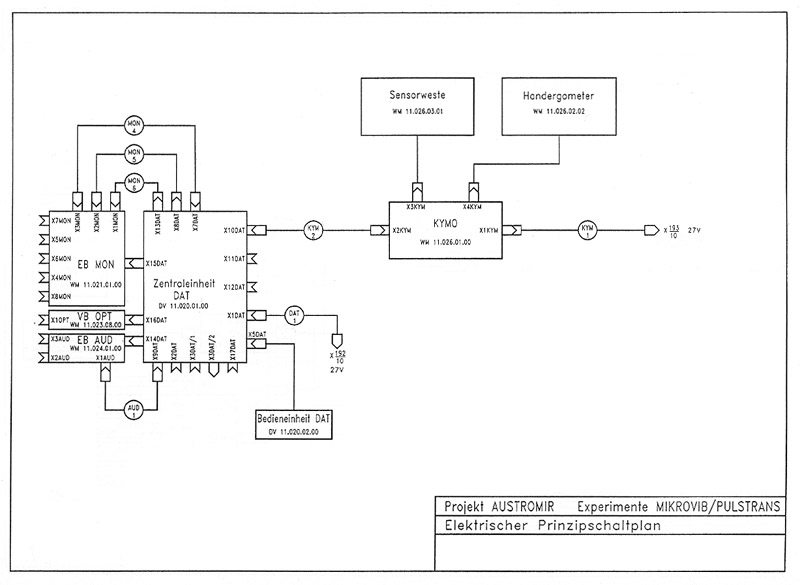
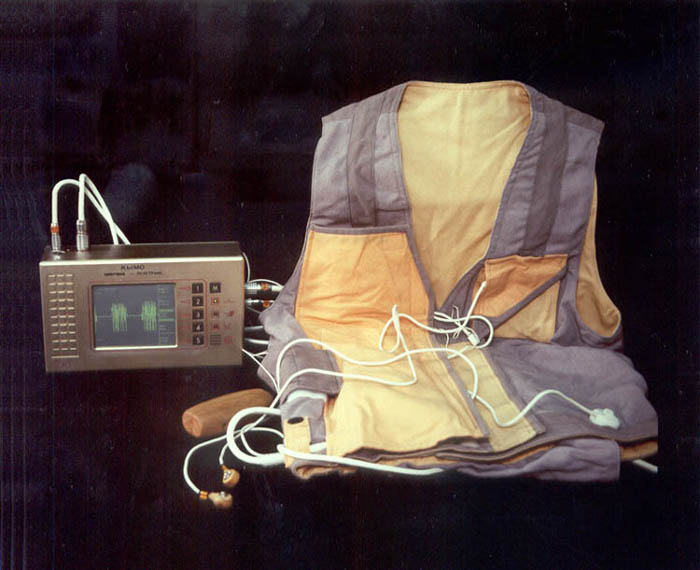
Aluminium container with foam coating
- Equipment KYMO
- Cable KYM1 (Power supply)
- Cable KYM2 (Connection KYMO – DATAMIR)
- Sensor vest with
Vibrostimulator
Accelerometer (2 pieces)
Puls sensores (3 pieces)
ECG – cable
Pre-amplifier unit - Hand ergometer
- Accessory sets for the experiment MIKROVIB (2 pieces)
Adherance rings (3 pieces), Adherance discs (6 pieces)
Cleaning tissues (2 pieces), ECG – Electrodes (3 pieces) - Accessory sets for the experiment PULSTRANS (2 pieces)
Adherance rings (3 pieces), Adherance discs (6 pieces)
Cleaning tissues (2 pieces), ECG – Electrodes (3 pieces) - Accessory sets for the experiment SLEEP (2 pieces)
Adherance rings (3 pieces), Adherance discs (6 pieces)
Cleaning tissues (2 pieces), ECG – Electrodes (3 pieces) - Fixing devices for the puls sensors (3 pieces)
- Adhesive tapes to fix the vibrostimulator and
accelerometer on the skin of the subject - Jig for the standardised fixation of vibrostimulator and
accelerometer on the skin of the subject - Reserve fuses
| Mass: | max. 6.2 kg |
| Dimensions: | 350 mm x 350 mm x 140 mm |
| Power input: | max. 35 W |
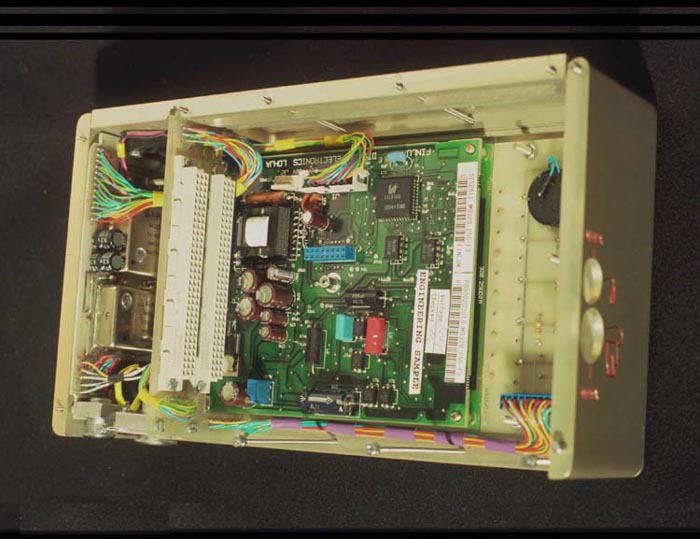
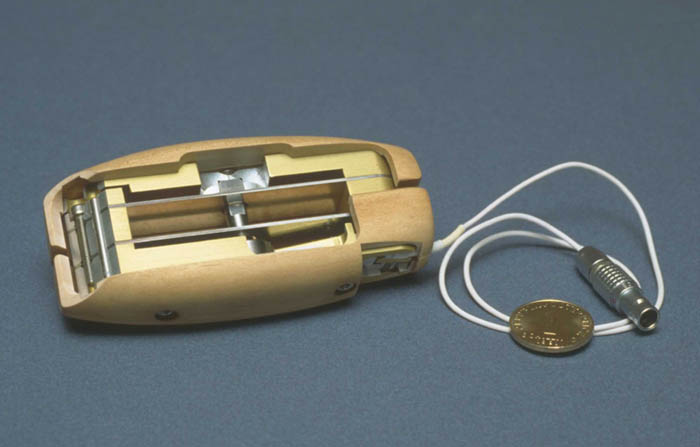
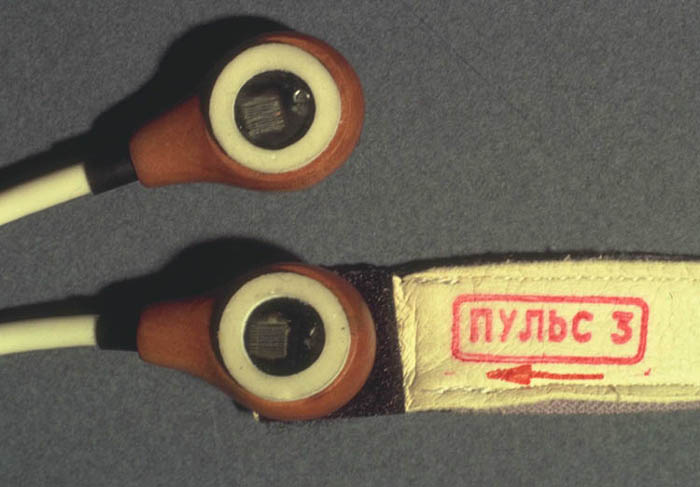
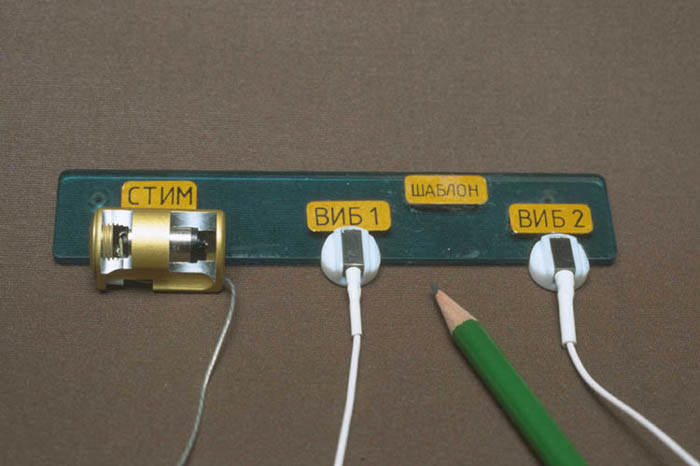
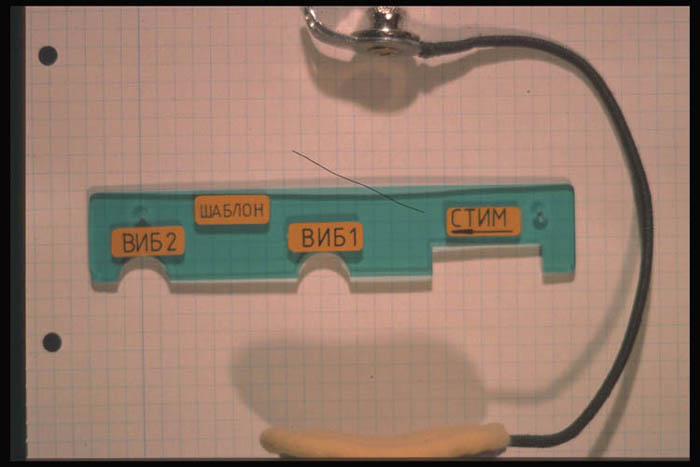
Photo 2 (top right): Profile from the hand ergometer with measuring cell (inside) and linden wood box (outside)
Photo 3 (middle left): 2 of 3 puls sensors from the equipment KYMO
Photo 4 (middle right): Vibrostimulator (left) und 2 sensors
Photo 5 (bottom): Standardised jig
Photos: Univ.-Prof. Dr. Maximilian Moser, Graz
Experimenters
o. Univ.-Prof. Dr. Thomas Kenner (institute manager)
Univ.-Doz. Dr. Maximilian Moser (project manager)
Dipl.-Ing. Dr. Eugen Gallasch
Dipl.-Ing. Dietmar Rafolt
Dipl.-Ing. Guenther Jernej
Josef Hindinger
Dr. Elisabeth Moser-Kneffel
Erich Maier
Dipl.-Ing. Guenther Griessmayr
all: Physiological Institute of the University Graz
